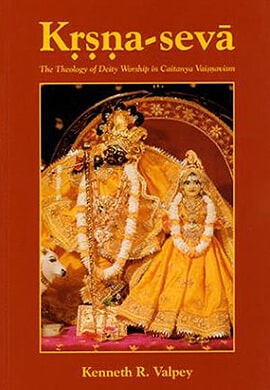A fair amount of literature has appeared in English on the history of Caitanya (Bengal) Vaiṣṇavism, focusing on a number of aspects. Yet there has been little attempt to explain to any significant extent the theology of the worship of images in the Caitanya tradition. Neither do we find any significant attempt to place the theology of image worship next to possible theological objections or reservations to image worship, especially as articulated in the Judeo-Christian traditions.
The worship of Krishna-images in temples and in homes is becoming increasingly part of the worldwide religious landscape. Varying degrees of unfamiliarity with the tradition make people think it foreign and exotic, if not threatening and demonic. Hence there is a need of attention to the theology of image worship to bring understanding and perhaps appreciation thereof. In light of this need for greater understanding of a tradition with growing popularity and growing presence due to an expanding worldwide Indian population, this thesis will be concerned to explore a central theological issue: In what sense, according to Caitanya Vaishnava theology, can an apparently inert material form be seen as divine and therefore worshipable, and in what ways is this practice of arcanam (formal worship of images) considered a solution to the problem of approaching or being approached by God in the Caitanya Vaishnava tradition?
The answers to these questions will be located in the interconnection between avatara (divine-descent) theology and devotional praxis, in which the Caitanya vedantic doctrine of acintya-bhedabheda-tattva-vada, or inconceivable simultaneous oneness and difference of the one supreme Being in relation to the multiplicity of being, is pivotal.
Since praxis is central to the Caitanya Vaishnava theology of image worship, I will briefly describe some specific daily ritual procedures in arcanam, such as the bathing and dressing of images, the offering of food, the waving of lamps, and the use of mantras. But as many of these details will appear similar to those in other image worship practices in South Asia, it will be important to direct attention to particularities of avatāra-theology in Caitanya Vaishnavism. These particularities are highlighted in aspects of a certain festival, the Jagannatha-Rathayatra, or public chariot-pulling festival of the image of “the Lord of the Universe,” and in scriptural narratives which celebrate the devotional accomplishments of Krishna-devotees.
The method employed in this thesis will be essentially theological explanation and comparison, written from the perspective of a long-time practitioner and teacher of arcanam and Krishna-bhakti within ISKCON (the International Society for Krishna Consciousness). I intend to show that image worship in this tradition is sustained in the dynamic relationship between the bhakta, or devotee, and Krishna, inasmuch as the presence of the deity is experienced through the practice of bhakti. Seen from a ‘functional’ perspective, as the focus of formal ritual in Caitanya Vaishnavism, the practice of image worship can be understood as a means to bring vital immediacy to the central message of bhakti, understood as a sustained transformational devotional attitude characterized by active service to the supreme divine Being, conceived in Caitanya Vaishnavism to be Krishna in his fullest manifestation. This immediacy of bhakti is suggested in the expression “Krishna-seva,” or “(direct) service to Krishna,” in which central importance is placed on the idea that the Lord makes himself accessible to devotees through active service performed according to a prescribed system of worship which might be thought of as “sustained hospitality.”
